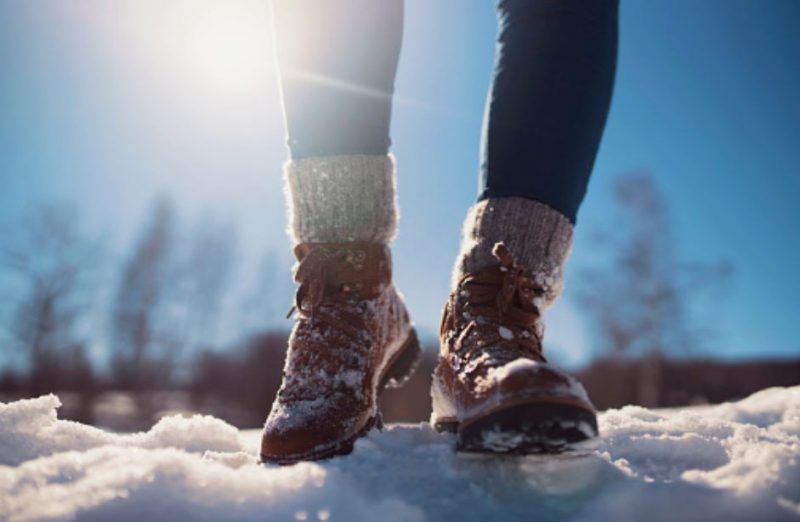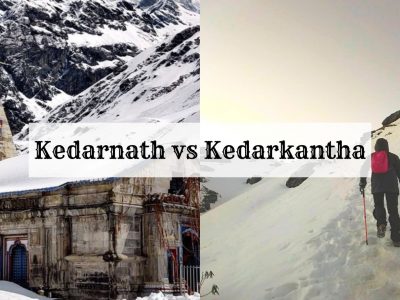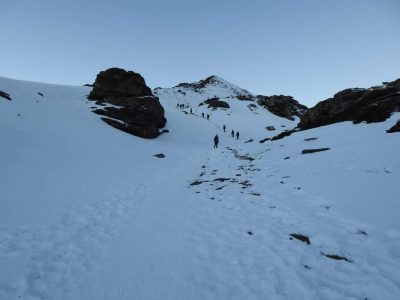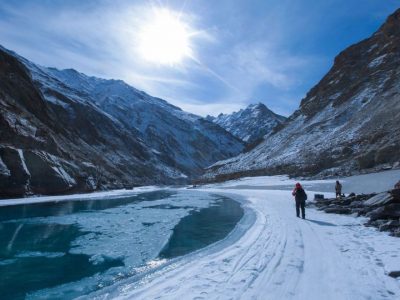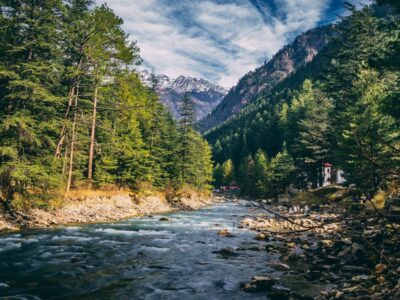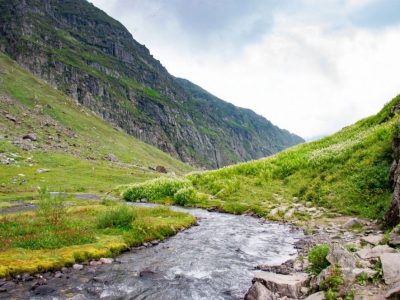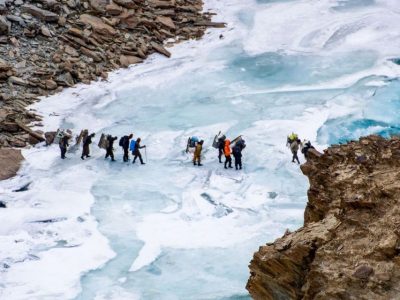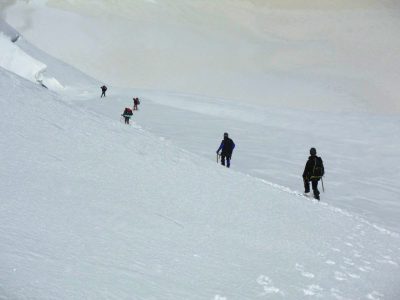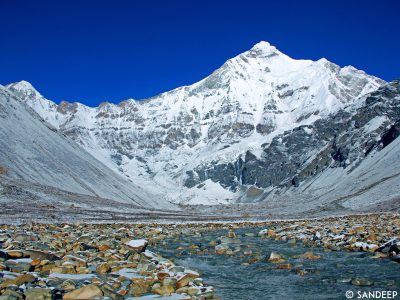Trekking in winter is a special treat for those who seek adventure. It can be a lot of fun and much less crowded than during the summer months. Everyone should, however, consider how to prepare for your trek. Things to carry while trekking in winter include:
1. Layers of Clothing
In winter, it can get cold. Really cold. Layers of clothing will help you stay warm during the day and at night after sunset. Carrying a down jacket is also recommended, as it’s lightweight and compact to pack in your backpack. Rather than carrying one warm jacket, pack several light clothes that you can wear layered together.
There’s a saying – When in mountains, dress like an onion.
It means you should have several layers of clothing. An onion starts off with a single leaf, which is the thinnest layer. Each additional layer gets thicker and should keep you warmer.
The first layer should wick away moisture from your skin and be a quick-drying material that won’t take too much space in your backpack.
The next layer should be insulating and keep you warm. A down jacket is great for this.
The shell layer should be waterproof and windproof. Gore-Tex jackets are recommended for this, or you can get one that’s simply water-resistant. It should be breathable but also keep the moisture out.
2. Head Torch
If you are going to be trekking in the night, or want to be able to move around the campsite at night. It is always recommended that you carry a head torch.
A head torch is better than a flashlight for trekking in winter because they are hands-free. It’s much easier to use your hands with a head torch, compared to a flashlight where you have to tuck it under your arm or between your teeth.
It’s also more practical for winter trekking as you can keep your gloves on when manoeuvring the head torch.
3. Sunglasses
Sunglasses are important especially if you plan to be trekking in snow. Snow reflects light, even during nighttime. It can get really bright and hurt your eyes. Sunglasses will help protect your eyes from the glare of snow and prevent snow blindness.
Make sure that your sunglasses are 100% UV protected and polarized.
If you want to know more about Snow Blindness, read here.
4. Sunscreen
In winter, you can get a sunburn when trekking in the snow because of the reflection of sunlight from the snow. Even on cloudy days, there’s the chance to get a sunburn.
It is recommended that you use sunscreen Make sure that you put on sunscreen before you leave.
Sunburn can be extremely painful and it’s no fun if you have to walk around with a sunburned face. It might also take a while for the skin to recover too, so prevent this by regularly applying sunscreen during your trek.
4. Lip Balm
Dry lips are common when it’s cold. The reason is that the skin on our lips has a hard time staying hydrated. Cold weather also dries out your lips faster than normal. To prevent dry and chapped lips, make sure you carry lip balm to moisturize your lips during the trek. You can put it on before you set off or whenever you feel like your lips are getting dry.
5. Snacks
Snacks are important for energy, especially while you’re trekking. Cereals and nuts are good options as they provide you with the energy you need without making you feel too full.
Cereal bars can also help if you want something sweeter like dessert, but make sure it’s something that doesn’t melt easily or become sticky in cold weather.
6. Waterproof Gloves
It’s essential to carry waterproof gloves so you can keep your hands warm and dry during the trek. You know how important it is to have warm hands!
If your hands are cold throughout the day, it will be much harder for you to stay warm and enjoy your trek. Make sure your gloves are waterproof and windproof. They should also be breathable enough that your hands won’t get hot and sweaty.
7. Waterproof Shoes
Waterproof shoes are important so your feet don’t get wet. If you’ve ever tried trekking in wet socks, you know how uncomfortable it can be.
Your feet can get damp if you walk through water or snow, so make sure the shoes are waterproof and high enough to protect your ankles too.
Make sure that your shoes are also fully sealed and that there is no space for water to leak in. If the shoes aren’t 100% waterproof, you can always use a waterproofing spray on them.
8. ORS (Oral Rehydration Solution)
ORS is a great way to prevent dehydration, especially if you’re trekking in cold weather. It contains electrolytes that will help replace the fluids that are lost when you sweat. It’s essentially like instant Gatorade!
Dehydration is more common in winter because it’s much harder to stay hydrated when you’re trekking in the cold. ORS replenishes the salts and minerals that your body loses during sweating.
It’s also important to drink enough water before and after your trek so that your body can stay hydrated.
You can purchase ORS from pharmacies or outdoor stores.
9. Warm cap and buff
A warm cap and buff is a great way to keep your head and neck warm.
Make sure it’s not too tight on your neck or you’ll find it uncomfortable during the trek. It should also fit well so that the cold doesn’t seep in through gaps.
A ski or beanie hat with a neck warmer will work well.
Neck warmers are also great because they can be pulled up over your ears to keep your head warm too.
10. Gaiters
Gaiters are an important part of winter trekking gear.
They keep snow out of your shoes, which can soak through and make your feet cold. Gaiters extend past your ankle so they should stop snow from getting in.
Make sure the gaiters are high enough and don’t have any holes! The best thing to do is take them out for a test run before you go on your actual trek, just to make sure they fit well and work properly.
11. Microspikes/Crampons
If you’re trekking in snow or on ice, crampons (or microspikes) will save you.
Crampons are metal spikes that attach to your shoes so you can walk across the snow and ice with ease. They help provide traction so you can walk more easily on snow and ice.
Microspikes are an alternative to crampons. They have the same basic function as on snow and ice but they’re not as heavy or expensive.
12. First-Aid Kit
It’s important to bring a first-aid kit with you when you’re trekking. You never know what might happen and it’s better to be safe than sorry!
Your kit should contain:
- Iodine/antiseptic wipes (to clean wounds)
- Gauze bandages
- Bandaids
- Medical tape (for bandages, splints, etc.)
- Painkillers like ibuprofen or paracetamol
Make sure your kit is waterproof and that all the contents are packed in ziplock bags so they don’t get wet.
13. Extra Socks
Wet socks are a terrible feeling.
If your feet get wet, you’ll end up with cold and damp feet which will make your trek harder. In winters, it’s important to keep your feet warm and dry.
Bring an extra pair of socks so if your feet do get wet, you can change them before it gets worse. Make sure the extra socks are dry too! If they’re wet, they won’t keep your feet warm at all.
14. Trekking Poles
If you’re trekking in winter, chances are there will be snow on the ground which means extra weight for you to carry with every step that you take. Trekking poles can help reduce the strain on your legs, knees, feet and hips. They also help provide stability when you walk on snow or ice so you don’t slip or fall.
15. Thermos flask
A thermos flask will keep water warm while you’re trekking, which is great for hydration. You can even bring along hot tea with you!
But make sure the lid of the thermos is tightly closed though; if it’s not, the liquid might spill out and make a mess.
No matter what the season, trekking can be a challenge. But if you prepare for it correctly and have all the right gear with you, your journey will go much more smoothly!
We hope this blog post has given you some helpful insight on how to plan for a winter trek in advance. If not, feel free to reach out to us anytime!




